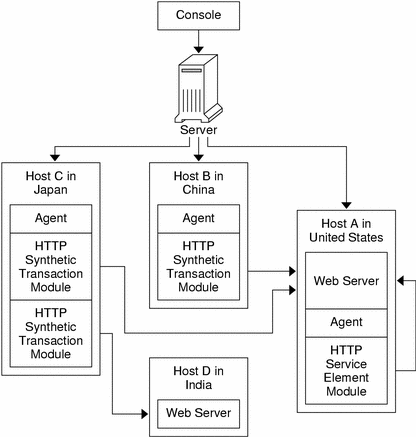Configuration Example
The following illustration depicts an example of how Service Availability Manager can be used in a network.
Figure 1–2 Configuration Example of Service Availability Manager

In this example, a single Sun Management Center server is shown with three agents:
-
Host A is located in the United States. A web server is running. An HTTP Service Element module is loaded.
-
Host B is located in China. An HTTP Synthetic Transaction module is loaded.
-
Host C is located in Japan. Two HTTP Synthetic Transaction modules are loaded.
-
Host D is located in India. The host does not have an agent. A web server is running.
With this configuration, the system administrator for Host A can monitor the web server that is running locally. The administrator can also check remotely from Hosts B and C on the status and performance of the web server on Host A. The HTTP Synthetic Transaction modules loaded on Hosts B and C enable this monitoring.
Host D has a web server running, but does not have an agent installed. The system administrator therefore cannot monitor the services locally. However, the services can be monitored remotely from Host C. The HTTP Synthetic Transaction modules loaded on Host C enables the remote monitoring of the web server on Host D.
- © 2010, Oracle Corporation and/or its affiliates
